Boudhanath
Boudha(Nepali: बौद्ध स्तुप, also called the Khāsa Chaitya, Nepal Bhasa Khāsti, Prachalit Nepal alphabet : 𑐏𑐵𑐳𑑂𑐟𑐶 𑐩𑐵𑐴𑐵𑐔𑐿𑐟𑑂𑐫, Standard Tibetan Jarung Khashor, Wylie: bya rung kha shor ) is a stupa in Kathmandu, Nepal.[2] Located about 11 km (6.8 mi) from the center and northeastern outskirts of Kathmandu, its massive mandala makes it one of the largest spherical stupas in Nepal[3] and the world.
| Bouddha Stupa 𑐏𑐵𑐳𑑂𑐟𑐶 𑐩𑐵𑐴𑐵𑐔𑐿𑐟𑑂𑐫 खास्ति माहाचैत्य, बौद्ध स्तूप | |
|---|---|
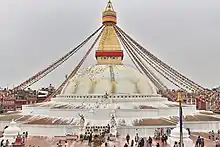 The Great Stupa | |
| Religion | |
| Affiliation | Buddhism, Hinduism |
| Location | |
| Location | Kathmandu, Nepal |
 Shown within Nepal | |
| Geographic coordinates | 27°43′17″N 85°21′43″E |
| Architecture | |
| Type | Stupa |
| Height (max) | 36 metres (118 ft)[1] |
| Official name: Bauddhanath, part of Kathmandu Valley | |
| Type | Cultural |
| Criteria | iii, iv, vi |
| Designated | 1979 (3rd session), revised 2006 |
| Reference no. | 121bis-005 |
| State Party | |
The influx of large populations of refugees from Tibet has seen the construction of over 50 gompas (Tibetan convent) around Boudha. As of 1979, Boudha Stupa is a UNESCO World Heritage Site. Along with Swayambhu, it is one of the most popular tourist sites in the Kathmandu area.
The stupa is on the ancient trade route from Tibet which enters the Kathmandu Valley by the village of Sankhu in the northeast corner and continues to the ancient and smaller stupa of Chā-bahī named Charumati Stupa (often called "Little Boudhanath"). It then turns directly south, heading over the Bagmati River to Lalitpur, bypassing the main city of Kathmandu (which was built later).[2] Tibetan merchants have rested and offered prayers at Boudha Stupa for many centuries. When refugees entered Nepal from Tibet in the 1950s, many decided to live around Boudhanath. The stupa is said to entomb the remains of Kassapa Buddha.

Mythology
Legend of the construction of the stupa according to Newar Buddhist mythology
According to the history of Nepal, the palace of King Bikramaditya (Licchavi King) once stood where the Narayanhiti Palace currently stands. King Vikramaditya instructed that a dhunge dhara should be built in the southern part of palace courtyard. But there was no sign of water from the dhunge dhara, for which the king consulted Astrologers. Astrologers suggested that a human sacrifice with a male candidate having Battis-Lakshanas, or thirty-two perfections[4] should be performed. Only the king himself and his two princes were suitable candidates. So, the king decided to sacrifice himself and ordered one of his sons to sacrifice him so that sign of water could be seen at the dhunge dhara. According to local mythology, during the time of sacrifice, the head flew off to a place nearby Sankhu Bajrayogini Temple.[5]
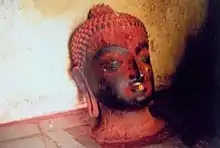
The prince then with a regretful heart, flew a hen from the top of Bajrayogini and decided to construct a stupa where the hen landed. The hen landed in the place where Boudhanath Stupa is currently standing. During the same time, the place was struck with a drought and the people managed to abate the scarcity of water by collecting the droplets of dew. So, the place was named Khāsti as in Nepal Bhasa, "khas" refers to dew and "ti" refers to drops.
Later His Majesty Government of Nepal renamed the place from Khasti to Boudhanath in order to reflect Hinduism as being the Hindu Nation.
Legend of the construction of the stupa according to Tibetan Buddhist mythology
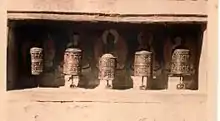
The village that surrounds the great Kāśyapa stupa is generally known by the name of Bauddha. ...which in Tibetan is called Yambu Chorten Chenpo (Tibetan: ཡམ་བུའི་མཆོད་རྟེན་ཆེན་པོ། Wylie: yam bu'i mchod rten chenpo). Jya Lung Khashor Chorten Chenpo, literally which may be translated as "Chorten of Hens skin-rope breach promise" The stupa has an interesting history of its own which explains this strange name.
It is said in this story that Kāśyapa was a Buddha that lived a long time before Śākyamuni Buḍḍha.
After Kāśyapa Buddha's demise, a certain old woman-Ma-jha-zi-ma (Tibetan: མ་བྱ་རྫི་མ། Wyle: ma bya rzi ma)who owned hens farm, with her four sons, interred this great sage's remains at the spot over which the great mound now stands, the latter having been built by the woman herself. Before starting on the work of construction, she petitioned the King of the time to grand a land size of a piece of skin and obtained permission to "proceed with" building a tower. the king was surprised how she going to build it on such small size of land, and gave her both land and permission. She then carefully cut the skin and made skin-rope (lung) and circulate the area. Which become the size of present area of Bouddhanath.
By the time that, as a result of great sacrifices on the part of the woman and her four sons, the groundwork of the structure had been finished, those who saw it were astonished at the greatness of the scale on which it was undertaken. Especially was this the case with the high officials of the country, who all said that if such a poor old dame were allowed to complete building such a stupendous tower, they themselves would have to dedicate a temple as great as a mountain, and so they decided to ask the King to disallow the further progress of the work. When the King was approached on the matter his Majesty replied: "I have finished giving the order to the woman to proceed with the work. Kings must not eat their words, and I cannot undo my orders now" which is known as (Kha-Shor), thus, the name came as Jya Lung Khashor. So the tower was allowed to be finished, and hence its unique name, "Jya Lung Kha-shor Chorten Chenpo."
Tamang[6] an ethnically tibetic group in Nepal, have been living in Boudha for many centuries and still own lands surrounding the area of Boudhanath stupa. Chiniya Lama and the daughter of Jung Bahadur Rana (through his Tamang wife who was born in Boudha) six times great grandchildren still manages the preservation of the stupa.[7]
History
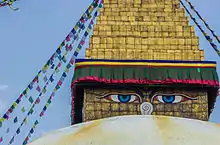
The Gopālarājavaṃśāvalī says Boudhanath was founded by the Nepalese Licchavi king Śivadeva (c. 590–604 CE); though other Nepalese chronicles date it to the reign of King Mānadeva (464–505 CE).[8][9] Tibetan sources claim a mound on the site was excavated in the late 15th or early 16th century and the bones of King Aṃshuvarmā 605–621 were discovered there.[10]
The earliest historical references to the Khaasti Chaitya are found in the Chronicles of the Newars. Firstly, Khaasti is mentioned as one of the four stupas found by the Licchavi king Vrisadeva (ca.AD 400) or Vikramjit. Secondly, the Newars legend of the stupa's origin attributes it to king Dharmadeva's son, Manadeva as atonement for his un writing parricide Manadeva was the great Licchavi king, military conqueror and the patron of the arts who reigned ca.AD 464–505. Manadeva is also linked with the Swayambhu Chaitya of Gum Bahal. Thirdly, another great Licchhavi king Shivadeva (AD 590–604) is associated with Boudha by an inscription; he may have restored the chaitya.

According to the history of Nepal, the palace of King Vikramjit (Licchavi King) once stood where the Naranhiti Palace currently stands. King Vikramjit instructed that a Hiti should be built in the southern part of palace courtyard, but there was no sign of water from the Hiti, for which the king consulted Astrologers. Astrologers suggested that a sacrifice with a male candidate having ‘swee-nita lachhyan'(स्वीनिता लछ्यन), or thirty-two perfections should be performed. Only the king himself and his two princes were suitable candidates. So, the king decided to sacrifice himself and ordered one of his sons to sacrifice him so that sign of water could be seen at the Hiti. The king told his son that a man will be sleeping by covering his face and body, and to sacrifice him without looking at his face. After the son did so, he realised he had killed his own father. With regret and guilty he consulted with priests for way to salvation. The priests suggested him to fly a ‘bwo-khaa'(ब्वःखा) a flying hen from the top of Mhaasu Khwaa Maju(म्हासु ख्वा: माजु). The hen landed in the place where the chaitya is currently standing. An Ajimaa was already located at that place before the chaitya construction started. During the time of its construction, the place was struck with a drought and the people managed to abate the scarcity of water by collecting the droplets of dew. Dew is called ‘Khasu'(खसु) and droplets are called ‘Ti'(ति).
Historians suggest that the traditional knowledge to harvest dew droplets have been lost with time. The places that end with ‘Ti'(ति) have similar history, such as Chalati(चलति), Kusunti(कुसिन्ति), and so on. Khaasti Ajimaa(खास्ति अजिमा) is one of the important Ajima of Kathmandu. The Newa tradition consider Ajima as super power. These female energies protect the nation. The tradition of Kumari relates to a place called ‘Kumari-gaal’ which is south to Khaasti.[12]
However, the emperor Trisong Detsen (r. 755 to 797) of the Tibetan Empire is also traditionally associated with the construction of the Boudhanath Stupa. The Yolmo Shakya Zangpo from Helambu resurrected Boudhanath. Princess of Nepal Bhrikuti married the King of Tibet Songtsen Gampo. His other Chinese wife and Bhrikuti are credited for introduction and spread of Buddhism in Tibet. Along Songtsen Gampo was Trisong Detsen, first Dharma King under him. While Buddhism was spreading in Tibet, and Tibet-Nepal trade relations were being stronger, a widow Tibetan woman travelled from Lhasa to visit Khaasti. She brought her four sons and they were fascinated by witnessing how Newa people constructed chaitya, a meta-symbolic construction with distinct levels of suggestion, sagacity and profoundness. The woman's name was Jyajhima, who took shade for many days in Khaasti. Impressed by the hospitality of Newars, she and her sons went back to Lhasa and told people stories about her experience in Nepal. She is notable as in those times, only traders and specially men were ones traveling Nepal-Tibet and back. She was fascinated by Khaasti, when she heard stories of Bhrikuti spread in Lhasa. Being a widow woman she had to ask permission from the king to visit Khaasti.
Jyajhima, a hen rearer woman is noted down by the local Newars of those times because of her attraction to the pilgrimage. It is said that she spend many days with her four sons in the premises of Khaasti before going back to Lhasa.[13]
2015 Earthquake
.jpg.webp)
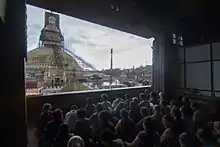
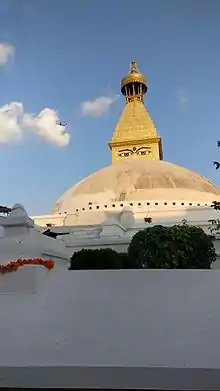
The April 2015 Nepal earthquake badly damaged Boudhanath Stupa, severely cracking the spire. As a result, the whole structure above the dome, and the religious relics it contained had to be removed, which was completed by the end of October 2015. The reconstruction began on 3 November 2015 with the ritual placement of a new central pole or "life tree" for the stupa at the top of the dome.[14]
The stupa was reopened on 22 November 2016. The renovation and reconstruction was organised by the Boudhanath Area Development Committee (BADC). The repairs were funded entirely by private donations from Buddhist groups and volunteers. According to the BADC, it cost $2.1 million dollars and more than 30kg of gold. The repaired building was officially inaugurated by Prime Minister Pushpa Kamal Dahal. However, the Nepalese government was criticised for its slow pace in reconstructing quake-damaged heritage structures such as temples, with many left unrepaired.[15][16]
After earthquake on 2015 photo gallery
 Wide view of Boudhanath Stupa
Wide view of Boudhanath Stupa Eyes of Boudhanath
Eyes of Boudhanath Boudhanath
Boudhanath A view of Boudhanath Premises
A view of Boudhanath Premises Boudhanath in the full moon day and Buddhajayanti
Boudhanath in the full moon day and Buddhajayanti Rain and public walking around Boudhanath
Rain and public walking around Boudhanath A bell in Boudhanath temple
A bell in Boudhanath temple Buddhists praying during a renovation of Boudhanath temple
Buddhists praying during a renovation of Boudhanath temple Boudhanath in the full moon day and Buddhajayanti
Boudhanath in the full moon day and Buddhajayanti Boudhanath in the full moon day and Buddhajayanti
Boudhanath in the full moon day and Buddhajayanti One of world heritage site of Nepal Boudhastupa
One of world heritage site of Nepal Boudhastupa Boudhanath after renovation.
Boudhanath after renovation. Boudhanath after renovation.
Boudhanath after renovation. Boudhanath
Boudhanath Flags Above Bodnath Stupa
Flags Above Bodnath Stupa
Panorama
See also
- Kora (pilgrimage)
- Swayambhunath
- List of Stupas in Nepal
References
- Department of Archaeology (Nepal). "Bouddha Stupa". Retrieved 3 May 2014.
- Snellgrove, David. Indo-Tibetan Buddhism: Indian Buddhists and Their Tibetan Successors, 2 vols., p. 365. (1987) Shambhala Publications, Boston. ISBN 0-87773-311-2 (v. 1); ISBN 0-87773-379-1 (v. 2).
- "Fables of Boudha Stupa and Changunarayan". nepalnews.com. Archived from the original on 2007-02-09. Retrieved 2007-07-30.
- "खास्ति चैत्य? बौद्धनाथ ? झ्यारुङ खास्योर ?". Rukshana Kapali. 2016-09-25. Retrieved 2018-01-25.
- "Bikram Sambat in Nepal". vijayvaani.com. Retrieved 2018-01-25.
- "Tamang people"
- Shah, Rishikesh (1990). Ancient and Medieval Nepal. Ratna Pustak Bhandar. p. 123. ISBN 978-0-7855-0252-4.
- Ehrhard, Franz-Karl (1990). "The Stupa of Bodhnath: A Preliminary Analysis of the Written Sources." Ancient Nepal - Journal of the Department of Archaeology, Number 120, October–November 1990, pp. 1-6.
- Ehrhard, Franz-Karl (1990). "The Stupa of Bodhnath: A Preliminary Analysis of the Written Sources." Ancient Nepal – Journal of the Department of Archaeology, Number 120, October–November 1990, pp. 7–9.
- Water Conduits in the Kathmandu Valley (2 vols.) by Raimund O.A. Becker-Ritterspach, ISBN 9788121506908, Published by Munshiram Manoharlal Publishers Pvt. Ltd., New Delhi, India, 1995
- "The Heritages of Nepal". Nepal heritage blog., archived from the original at Archive.org
- The Legend of the Great Stupa and The Life Story of the Lotus Born Guru, pp. 21–29. Keith Dowman (1973). Tibetan Nyingma Meditation Center. Dharma Books. Berkeley, California.
- "Boudha Stupa". Nepal Trekking. Retrieved 22 August 2019.
- "Nepal's earthquake-hit Boudhanath stupa reopens after restoration". The Guardian. 22 November 2016. Retrieved 22 August 2019.
- "Nepal earthquake: Boudhanath monastery reopened". BBC News. 22 November 2016. Retrieved 22 August 2019.
Further reading
- The Legend of the Great Stupa and The Life Story of the Lotus Born Guru. Keith Dowman. (1973). Tibetan Nyingma Meditation Center. Dharma Books. Berkeley, California.
- Psycho-Cosmic Symbolism of the Buddhist Stūpa. Lama Anagarika Govinda. (1976) Dharma Books. Berkeley, California. ISBN 0-913546-35-6; ISBN 0-913546-36-4 (pbk).
- Korn, Wolfgang (2015), The Traditional Newar Architecture of the Kathmandu Valley: The Stūpas and the Chaityas, Kathmandu, Nepal: Ratna Pushtak Bhandar, ISBN 9789937330848, OL 26451007M
- Karki, Binod; Shrestha, Sachin Yagol (2016), The Great Boudha Stupa, Kathmandu, Nepal: Shree Boudhanath Area Development Committee, ISBN 9789937005326
External links
| Wikimedia Commons has media related to Boudhanath. |
| Wikivoyage has a travel guide for Boudhanath. |
- Kathmandu heritage sites listed by UNESCO Nepal
- Boudhanath at Khandro.net : Information on Legends and Prophecies
- The History of the Great Jarung Kashor Stupa of Boudhanath : English Translation of the 15th-century Tibetan History

